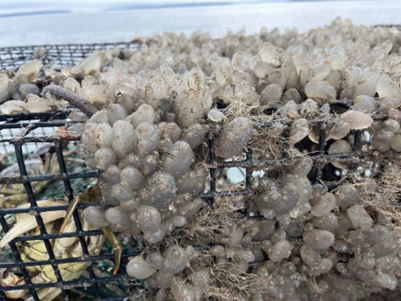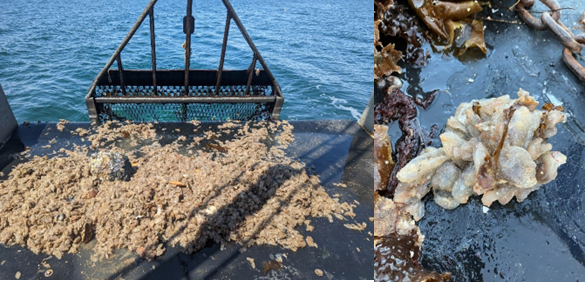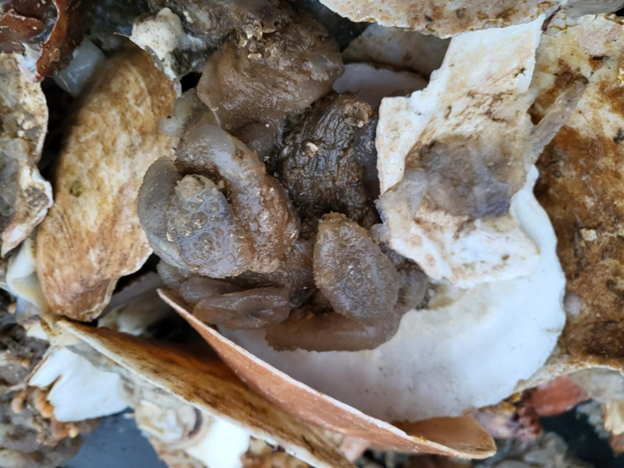Tunicates, also known as sea squirts or salps, are marine invertebrates that spend most of their life attached to a solid surface including man-made structures. They are filter feeders that consume mostly bacteria and other small particles in the water. They can live as individuals or colonies that grow over time. Warming Gulf of Maine waters have allowed tunicates to grow quickly in many parts of the Maine coast. They also are less susceptible than many invertebrates to the impacts of ocean acidification and the low oxygen conditions created by algal blooms in coastal areas making them successful since the early 2000s.
Tunicates can also be easily introduced into the Gulf of Maine in ballast water, on mobile gear, or through their ability to extend their range by surviving in a broad range of conditions. Their rapid growth allows them to compete for space, food, and oxygen and drive out other species from many areas. This can reduce the amount of available habitat for a broad range of benthic seaweeds and animals. Tunicates have few Gulf of Maine predators, but may be a possible secondary food source for skates, crabs, and urchins.
What DMR programs document or measure them?
No programs are dedicated specifically to tunicate research, but tunicates are documented in the following DMR programs:
-
The ME-NH Inshore Trawl Survey has measured biomass per tow of tunicates since 2018. This is a coastwide survey that occurs each May and October.
-
The Urchin Dive Survey records the presence of an invasive tunicate species (Pancake Batter tunicate, Didemnum vexillum) in each Spring dive survey transect since 2007. Survey sites vary over time but most data collected in this time has been in Urchin Zone 2 (Penobscot Bay to Lubec).
-
The Scallop Survey estimates volume of tunicates per tow in the spring and fall surveys. Since 2021, the Scallop program also photographs and identifies tunicates as able. Survey sites vary over time these surveys operate in scallop Zone 2 (Penobscot Bay to Lubec) and Zone 3, Cobscook Bay.
Please contact program leads for additional information about tunicate data collected by each survey.
Are tunicates invasive?
There are over 3,000 tunicate species worldwide with many native to the Gulf of Maine but in recent years (early 2000s) DMR and other researchers have noted the presence of invasive tunicates increasing in numbers. These include two types:
-
Solitary tunicates (the club sea squirt (Styela clava), the sea vase (Ciona intestinalis, unknown origin but considered a nuisance), and the European sea squirt (Ascidiella aspersa). These species reproduce quickly and can easily spread into new areas by attaching themselves to boats or gear. See: https://www.mass.gov/doc/new-england-marine-invader-id-cards-solitary-tunicates/download
-
Colonial tunicates (the pancake batter (or sea vomit) tunicate (Didemnum vexillum), chain (or sheath) tunicate (Botrylloides violaceus), the golden star tunicate (Botryllus schlosseri), and the diplosoma (or jelly crust) tunicate (Diplosoma listerianum)). See: https://www.mass.gov/doc/new-england-marine-invader-id-cards-colonial-tunicates/download
How do you tell the difference between types?
Tunicates in coastal Maine waters can be broken down into two primary groups, solitary and colonial. While some species can be identified by their appearance, the best way to confirm identification is through DNA sequencing. If you would be interested in identifying a tunicate in your area, please feel free to contact DMR staff. Below are some examples.
Solitary tunicates, while they can occur in large groups, are visually distinct individuals. Each soft-bodied individual has two siphons (in & out) at the top that can squirt out water (thus the term “sea squirt”), and a body contained within a robust membrane known as the tunic. Both the European sea squirt and club tunicate have bumpy bodies. The European sea squirt is generally grey with a semi-translucent, bumpy tunic while the club tunicate has a brownish, leathery tunic that appears warty, The latter has a body that tapers down to a narrow stalk attaching it to the substrate. Another species, the sea vase (Ciona intestinalis), can be quite prolific. This species is most similar to the European sea squirt but is more transparent, displays a smooth, soft tunic with no bumps, can be a variety of different colors, and has siphons ringed in yellow.
Solitary tunicates reproduce sexually but are hermaphroditic (=single individual releases both eggs and sperm). Some species can self-fertilize, while others, like the sea vase tunicate, cannot. Some species hold fertilized eggs internally until they hatch into larva and released into the water column, and other release both eggs and sperm into the water column where they become fertilized, grow, and then hatch into tadpole-like larva. These free-swimming larva only spend about a day in the water column before they settle and attach to something, and therefore have limited larval dispersal distance (about 6km per generation for the sea vase tunicate; Kanary et al. 2011; Collin et al. 2013). They then spend the rest of their lives filtering out food from the water and reproducing. The sea vase tunicate especially is robust against low salinity.
Colonial tunicates are individual animals that live as colonies within a shared protective tunic. These look like gelatinous, colonial coatings covering both biological and man-made substrates. The chain tunicate can be vibrantly colored from bright orange to deep purple, and has a chain-like pattern of individuals visible below the tunic. The golden star tunicate can also be a variety of colors, but has a distinct golden star-like patterns of individuals below the tunic. The pancake batter tunicate is generally more tan in color, with individuals more randomly arranged but with small white dots in the tunic. This tunicate has earned the name “pancake batter” because dense colonies can form a mat with dripping tendrils coming off it. The diplosoma tunicate is gray to tan colored with a more milky transparent appearance. This is one of the slimier invasive species.
Colonial tunicates are also hermaphroditic and can reproduce sexually by either self-fertilization or fertilization with a nearby individual. The larvae that hatch stay relatively close (generally less than 1km; Fletcher et al. 2012) during their less than 36 hours in the water column. For animals that only have one to three generations a year, this limits their dispersal. However, unlike solitary tunicates, they can also reproduce by budding off a piece of their body to create a cluster of multiple individuals (colonies). This also means that a fragment broken off from a tunicate colony can float away, reattach to a new surface, and continue to grow. Species like the pancake batter tunicate attach and grow more quickly at winter temperatures than at summer temperatures. Anthropogenic structures, such as floating docks, buoys, aquaculture structures, and boat hulls frequently house colonial tunicates like the chain tunicate over natural habitat.



What can we do about them and what are best practices?
-
DMR does not have a program or planned program for removal of populations that are established in the GOM. Efforts recommended are for mitigation of current species and preventing the introduction of new tunicate species.
-
Advise industry to remove from gear before changing location.
Tunicates cannot survive drying out, so the best way to eliminate them from gear is to remove the gear from the water and scrap off the tunicates after they have dried. They will also not survive significant rain events, so leaving gear in the rain may also reduce their presence. It is very difficult to remove them from structures or gear in the water. Additionally, colonial tunicates can reproduce asexually, which further complicates removal strategies. Simply scraping them off equipment and back into the water breaks them into pieces, but because these pieces are still alive, they can each grow into more living colonies.
Not all treatments work on every species. White vinegar spray has been identified as a treatment for Styela and Botrylloides on aquaculture equipment and on mussels. Pressure washing can be used to clean equipment and vessels, but only onshore so as not to re-introduce tunicates into new areas of the ocean.
Identification of infested areas and subsequent restriction of the movement of aquaculture and fishing gear slows the spread of invasive tunicates through containment. This has been a preferred method among aquatic resources users around PEI (see Locke (2009) for examples). In general, once tunicates are established, they are difficult to contain and nearly impossible to eradicate.
Other Resources
-
Andrea Locke (2009) “A screening procedure for potential tunicate invaders of Atlantic Canada”
-
Marine Invasive Species Identification Cards: Solitary Tunicates